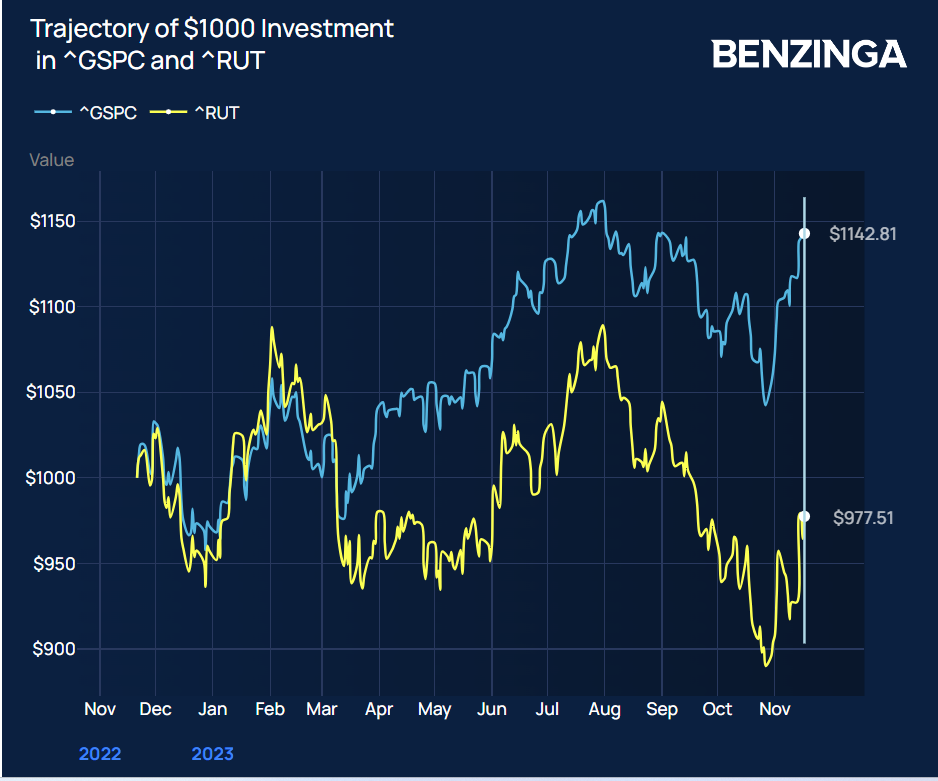Small-Caps Grossly Underperform Broader Market Amid This Red Flag: 5 Stocks On The Scanner
Small-cap stocks have underperformed their mid- and large-cap counterparts in the broader market recovery seen since late October.
Underwhelming Show: The S&P 600 and the Russell 2,000 Indices, which comprise small-cap stocks, are barely in the green even as the major averages are solidly higher despite the slackness seen in the August-through October period.
The broader market has recovered from the three-month slump and is on the way higher, hoping for a Fed pivot amid a cool-off in inflationary pressure driving the upside. From the October 27 intraday low of 4,103.78, the S&P 500 has run up 10%, and so have the S&P 600 and the Russell 2,000 indices. These two indices have grossly underperformed the S&P 500 Index for the year.
Compared to the 17.6% year-to-date gain for the broader S&P 500 Index, the S&P 600 and Russell 2,000 are up merely 1.18% and 2.07%, respectively.

Chart Courtesy of Benzinga
See Also: Best Penny Stocks
What Ails Lesser Knowns: Small-caps may have been hurt by the Federal Reserve’s successive rate hikes implemented since March 2023, a Wall Street Journal report said. It added that these companies raise finances through floating-rate debt and are thereby not insulated against the interest-rate vagaries. From near-zero levels, the Fed funds rate is currently at a 22-year high of 5.25%-5.50%.
The Journal said that about 40% of S&P 600 companies have outstanding floating-rate debt with shorter maturities compared to a more modest 10% of the S&P 500 companies, citing the JPMorgan Equity Macro Research team. It said that small-cap companies are unlikely to benefit from a Fed pause and stand to gain only when the central bank begins cutting rates.
The report highlighted media company The E.W. Scripps Company (NASDAQ:SSP), theme park operator Six Flags Entertainment Corporation (NYSE:SIX), and sports and outdoor equipment maker Vista Outdoor Inc. (NYSE:VSTO) as small-cap names that are stymied by higher interest burden despite the underlying debt declining from the year-ago levels.
Potential Red Flag: Benzinga screened some companies with a high debt-to-equity ratio. Ideal debt-to-equity is traditionally considered to be 2:1. About 331 of small-cap stocks have a long-term debt/equity ratio of over 2:1, and 413 have total debt/equity exceeding the mark.
Some stocks with elevated total equity ratio include:
- NovaGold Resources Inc. (NYSE:NG)
- Chicken Soup for the Soul Entertainment, Inc. (NASDAQ:CSSE)
- Gamida Cell Ltd. (NASDAQ:GMDA)
- J.Jill, Inc. (NYSE:JILL)
- Hanesbrands Inc. (NYSE:HBI)
The above stocks were screened based on their debt-to-equity ratio, and the interest expense was not taken into account.
The WSJ reported that interest expenses at Scripps, Six Flags, and Vista Outdoor rose about 35% and 12% and 20%, respectively, in the third quarter related to the year-ago period.
Erik Knutzen, multiasset class chief investment officer at Neuberger Berman, said he is looking to pare back exposure to some small-caps with high financial and operational leverage, the report said. The analyst cited unprofitability and junk-rated debts as reasons for the same.
The SPDR Portfolio S&P 600 Small Cap ETF (NYSE:SPSM) ended Friday’s session at $37.63, up 1.07%, according to Benzinga Pro.
Read Next: Golden Opportunity: Portfolio Manager Highlights Unprecedented Discount In Gold Mining Stocks
